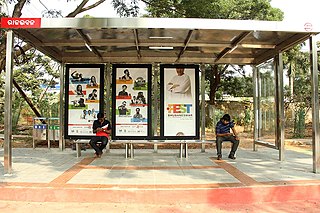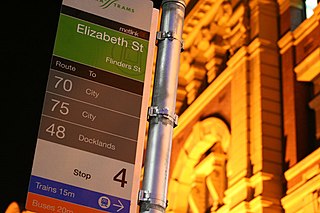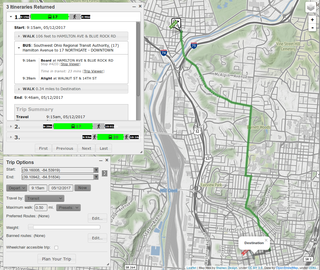
A bus stop is a place where buses stop for passengers to get on and off the bus. The construction of bus stops tends to reflect the level of usage, where stops at busy locations may have shelters, seating, and possibly electronic passenger information systems; less busy stops may use a simple pole and flag to mark the location. Bus stops are, in some locations, clustered together into transport hubs allowing interchange between routes from nearby stops and with other public transport modes to maximise convenience.

Metlink was the marketing body and umbrella brand for public train, tram and bus transport operators in Melbourne, Australia. On 2 April 2012, the operations of Metlink were transferred to the newly created public transport planning and management authority, Public Transport Victoria.

London Buses is the subsidiary of Transport for London (TfL) that manages most bus services in London, England. It was formed following the Greater London Authority Act 1999 that transferred control of London Regional Transport (LRT) bus services to TfL, controlled by the Mayor of London.

The National Public Transport Access Node (NaPTAN) database is a UK nationwide system for uniquely identifying all the points of access to public transport in the UK. The dataset is closely associated with the National Public Transport Gazetteer.

The South Yorkshire Passenger Transport Executive is the passenger transport executive for South Yorkshire in England. It is supervised by the South Yorkshire Mayoral Combined Authority, which consists of representatives from the metropolitan boroughs of Sheffield, Rotherham, Doncaster, and Barnsley.

The Transport Direct Programme was a division of the UK Department for Transport (DfT) to develop standards, data and better information technology systems to support public transport. It developed and operates the Transport Direct Portal which is a public facing multi-modal journey planner. It also supports the creation and management of comprehensive databases of all public transport movements in the United Kingdom with Traveline. During 2010 two key datasets were released as Open Data and published on www.data.gov.uk.

A passenger information system, or passenger information display system, is an automated system for supplying users of public transport with information about the nature and the state of a public transport service through visual, voice or other media. It is also known as a customer information system or an operational information system. Among the information provided by such systems, a distinction can be drawn between:

A public transport timetable is a document setting out information on public transport service times, to assist passengers with planning a trip. Typically, the timetable will list the times when a service is scheduled to arrive at and depart from specified locations. It may show all movements at a particular location or all movements on a particular route or for a particular stop. Traditionally this information was provided in printed form, for example as a leaflet or poster. It is now also often available in a variety of electronic formats.
The National Public Transport Gazetteer (NPTG) provides a topographic database of towns and settlements in the UK; it provides a common frame of reference for the National Public Transport Access Nodes (NaPTAN) schema and other UK Public Transport Information schemas such as JourneyWeb.
The Real Time Information Group is an organisation in the United Kingdom supporting the development of bus passenger information systems; its 45 members include local authorities, bus operators, consultants and system suppliers together with representatives from the UK government.
TransXChange is a UK national XML based data standard for the interchange of bus route and timetable information between bus operators, the Vehicle and Operator Services Agency, local authorities and passenger transport executives, and others involved in the provision of passenger information.

A journey planner, trip planner, or route planner is a specialized search engine used to find an optimal means of travelling between two or more given locations, sometimes using more than one transport mode. Searches may be optimized on different criteria, for example fastest, shortest, fewest changes, cheapest. They may be constrained, for example, to leave or arrive at a certain time, to avoid certain waypoints, etc. A single journey may use a sequence of several modes of transport, meaning the system may know about public transport services as well as transport networks for private transportation. Trip planning or journey planning is sometimes distinguished from route planning, which is typically thought of as using private modes of transportation such as cycling, driving, or walking, normally using a single mode at a time. Trip or journey planning, in contrast, would make use of at least one public transport mode which operates according to published schedules; given that public transport services only depart at specific times, an algorithm must therefore not only find a path to a destination, but seek to optimize it so as to minimize the waiting time incurred for each leg. In European Standards such as Transmodel, trip planning is used specifically to describe the planning of a route for a passenger, to avoid confusion with the completely separate process of planning the operational journeys to be made by public transport vehicles on which such trips are made.

The Transport Direct Portal was a distributed Internet-based multi-modal journey planner providing information for travel in England, Wales and Scotland. It was managed by Transport Direct, a division of the Department for Transport. It was launched in 2004 and was operated by a consortium led by Atos and later enhanced to include a cycle journey planning function. The closure of the portal was announced in September 2014 "Closure of the Transport Direct website"(PDF). Archived from the original(PDF) on 12 September 2014. and the portal closed on 30 September 2014.
CycleNetXChange provides a standard format with which to exchange cycle path data, together with information about the quality of routes; This enables computerised transport systems to provide cycle routes.
Trapeze Software Inc. is an operating company of Volaris Group which is an operating group of Constellation Software that is engaged in the development, installation and customization of intelligent transportation systems. Its product offerings include scheduling, route optimization, staffing asset management, and communication systems. The division is headquartered in Mississauga, Ontario, and has offices across Canada and the United States, with operating subsidiaries across North America, Northern Europe, Australia and the United Kingdom

Intalink is the organisation responsible for organising the management of public transport services, such as buses and trains, in Hertfordshire on behalf of Hertfordshire County Council. They design, create and promote cross-operator multi-journey tickets and occasionally run competitions. They manage Quality Bus Partnerships maintaining good standards along routes that need it. Along with this, they provide printed timetables, maps and leaflets promoting the above services.
Crown Copyright has been a long-standing copyright protection applied to official works, and at times artistic works, produced under royal or official supervision. In 2006, The Guardian newspaper's Technology section began a "Free Our Data" campaign, calling for data gathered by authorities at public expense to be made freely available for reuse by individuals. In 2010 with the creation of the Open Government Licence and the Data.gov.uk site it appeared that the campaign had been mostly successful, and since 2013 the UK has been consistently named one of the leaders in the open data space.
The Association of Transport Coordinating Officers was formed in 1974, joining initially senior Public Transport officers of local government around the UK. Although limited to 'lead officers', the organisation spread quickly from just upper tier county authorities to all transport authorities around the UK.

Contact Centre Cymru is a bilingual Contact Centre, based in Penrhyndeudraeth, North Wales. Owned and managed as a business unit of PTI Cymru Ltd, it provides a Contact Centre service to a range of businesses across Wales and the UK, including Traveline Cymru., Bwcabus, First Cymru, Severn Trent Water, National Rail Enquiries and Arriva Trains Wales.
Bustimes.org is a transportation information website created to take advantage of Bus Services Act 2017 requirements for bus operators by the Department for Transport that bus timetables, fares and vehicle locations could be provided in an open data format, which can be utilised by app and website developers. This DfT service is called the Bus Open Data Service.











